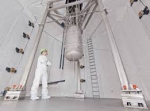Displaying items by tag: LUX (dark matter detector)
LUX dark matter detector
The Large Underground Xenon Detector (LUX) is a 370 kg liquid xenon physics experiment that aims to directly detect interactions between Weakly Interacting Massive Particle (WIMP) dark matter and ordinary matter on Earth.
Despite the wealth of evidence supporting the existence of non-baryonic dark matter in the Universe, dark matter in our galaxy has never been directly detected on Earth. The LUX experiment utilizes a large detector mass in a time-projection chamber (TPC) configuration to identify individual particle interactions in the liquid xenon volume, which will allow it to look for faint dark matter interactions with unprecedented sensitivity.
The LUX experiment is located 4,850 ft (about 1 mile) underground at the Sanford Underground Research Facility (formerly the Deep Underground Science and Engineering Laboratory) in Lead, South Dakota. Underground, the detector is located in the Davis campus, the former site of the Nobel-prize winning Homestake neutrino experiment led by Raymond Davis. The LUX experiment needs to be operated underground in order to reduce signal background caused by high-energy cosmic rays at the Earth's surface.
The LUX experimental collaboration is composed of more than 100 scientists and engineers across 18 institutions in the US and Europe.
The detector assembly began in late 2009. The fully assembled detector was transported from the surface laboratory to the underground space in a two-day operation in the summer of 2012.


